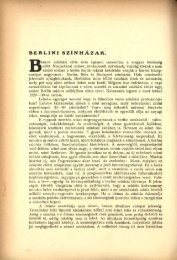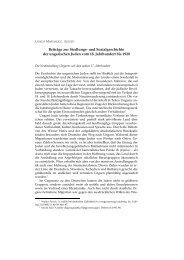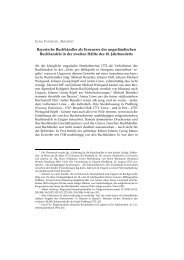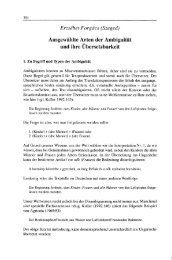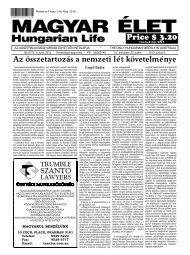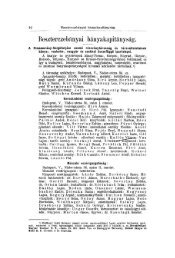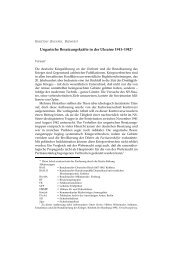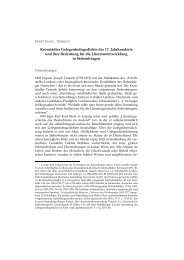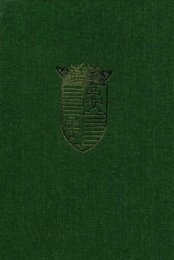Journal of Eurasian Studies - EPA
Journal of Eurasian Studies - EPA
Journal of Eurasian Studies - EPA
You also want an ePaper? Increase the reach of your titles
YUMPU automatically turns print PDFs into web optimized ePapers that Google loves.
April‐June 2010 JOURNAL OF EURASIAN STUDIES Volume II., Issue 2.<br />
_____________________________________________________________________________________<br />
industry in Austria‐Hungary. He founded the Oriental Museum in Vienna and was one <strong>of</strong> the highest<br />
sponsors for the Austro‐Hungarian North Pole Expedition to Franz Jozef Land. His son Jenő, inherited his<br />
father’s notable collection and followed in the footsteps <strong>of</strong> his father. Jenő studied Law in Germany, was a<br />
landowner, a member <strong>of</strong> the Hungarian Parliament and President <strong>of</strong> the Hungarian National Industrial<br />
Council. Because <strong>of</strong> his activities in the field <strong>of</strong> economy and industry, he was nicknamed the ‘industry<br />
count’. (…)<br />
It was not by accident that Count Zichy invited Bálint de Szentkatolna to be a member <strong>of</strong> his 1895<br />
expedition. The Székely linguist, who only joined Zichy’s first expedition to the Caucasus and Central<br />
Asia in 1895, and Count Zichy were actually brothers in arms. They shared the same views on the ancient<br />
history <strong>of</strong> the Hungarians. Bálint de Szentkatolna and Count Zichy both strongly opposed a<br />
one‐sided Finno‐Ugric origin <strong>of</strong> the Hungarians; and they both considered the Hungarians to be<br />
descendants <strong>of</strong> the Huns and hypothesized that one <strong>of</strong> ancient Hungarian homelands must have been<br />
somewhere in the area north <strong>of</strong> the Caucasus, neighbouring the South Russian Steppes, continuously<br />
inhabited by the Scythians, Sarmatians, Huns, Avars, Magyars and other steppe peoples, migrating from<br />
the East westwards. Hence, the expedition was meant to contribute evidence to this hypothesis by<br />
studying the languages, people and cultures <strong>of</strong> the Caucasus. (…)<br />
The fact that the expedition was intended to challenge the <strong>of</strong>ficial view on the Hungarian ancient<br />
history that claims that the Hungarians originate from the Nordic Ural area might explain the lack <strong>of</strong><br />
interest Count Zichy engaged from the Hungarian government and the Hungarian Academy <strong>of</strong> Sciences.<br />
Count Zichy complained: ’I had the duty to ask every minister who was in charge <strong>of</strong> one <strong>of</strong> my functions,<br />
including my membership <strong>of</strong> the Industrial Council, the Monuments’ Council and so on for a holiday (…)<br />
with the only exception <strong>of</strong> Ernő Dániel, I received no answer (…). 17 The Academy remained completely<br />
silent, although I only asked for a certificate to verify that I am Zichy.’ 18 The expedition was however<br />
welcomed by the Russian Czar, Nicolas II (1868‐1918) and his government, although the Hungarians were<br />
forbidden to dig in Russian soil. (…)<br />
This Zichy‐expedition to the Caucasus has been recorded by Lajos Szádeczky‐Kardoss in his<br />
stenographic travel diary. The original diary <strong>of</strong> the 1895 expedition – together with seven original photos<br />
– is presently kept in the library <strong>of</strong> the Hungarian Academy <strong>of</strong> Sciences. This diary has recently been<br />
decoded by the Hungarian stenographer Pálma Schenken, who succeeded in deciphering the 400<br />
handwritten pages denoted in the style <strong>of</strong> the nineteenth‐century Gabelsberger‐Markovits version <strong>of</strong><br />
17 Baron Ernő Dániel was minister <strong>of</strong> Trade between 1895‐1899 in the Bánffy‐government. He was the nephew <strong>of</strong> the Hungarian<br />
honvéd general Ernő Kiss, who fought against the Austrians in the Hungarian War <strong>of</strong> Indepencence, 1848‐1849. Kiss was one <strong>of</strong><br />
the 13 Martyrs <strong>of</strong> Arad, the thirteen Hungarian freedom fighter generals who were executed on October 6, 1849 in the<br />
Transylvanian city <strong>of</strong> Arad (presently in Romania) to reestablish Habsburg rule over Hungary. The Baron had another reason to<br />
support the Caucasian expedition <strong>of</strong> Zichy. The wealthy Dániel family, who had its estates in Transylvania, was <strong>of</strong> Armenian<br />
origin.<br />
18 Szádeczky‐Kardoss (2000, 11).<br />
_____________________________________________________________________________________<br />
© Copyright Mikes International 2001‐2010 89



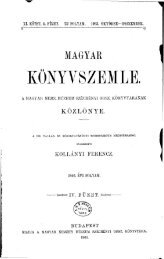
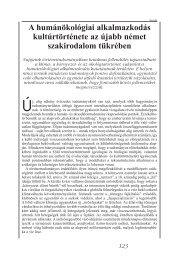
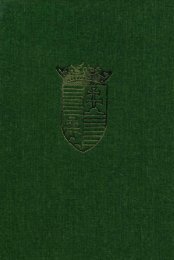
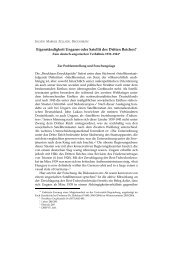
![Letöltés egy fájlban [36.8 MB - PDF] - EPA](https://img.yumpu.com/23369116/1/172x260/letoltes-egy-fajlban-368-mb-pdf-epa.jpg?quality=85)
